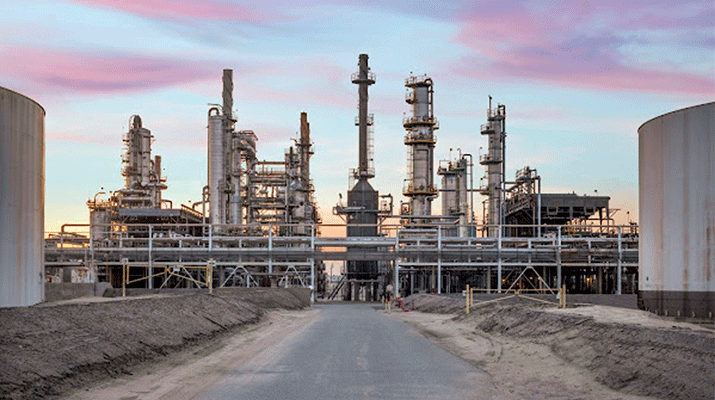Renewable propane: Diverse players seek production pathways
Think of propane, and a number of images may spring to mind.
Maybe it’s bobtails, tanks or a blue flame. Maybe it’s pipelines or the fracking rigs that ushered in a boom in propane production over the past 15 years.
But when Global Clean Energy, a California-based renewable fuels business, thinks about propane, it sees vast, verdant farms.

Camelina sativa is a nonfood rotation crop that produces small, oily seeds ideal for renewable fuel production. (Photo courtesy of Global Clean Energy)
The vertically integrated company is poised to produce renewable propane and other products from camelina sativa, a fast-growing, nonfood rotation crop that produces small, oily seeds ideal for renewable fuel production.
Pledging that “sustainable agriculture is the new upstream,” the company has bred and patented camelina varieties for quick maturity, low water use, high yield and a plant oil chemistry that enhances refinery efficiency. In the U.S., the company partners with farmers in Montana, Colorado, Kansas, Oregon and Washington to grow the crop. It then transports the yield to a strategically located refinery in Bakersfield, California, where it’s processed, with other feedstocks, into renewable diesel, naphtha, propane and butane.
Like all renewable propane producers currently on line, Global Clean Energy optimizes for renewable diesel in its refining process. The Bakersfield plant, not yet operational, claims a nameplate capacity of about 210 million gallons of renewable diesel per year. Renewable propane output equates to 6 percent to 10 percent of the renewable diesel output, or an estimated 13 million to 21 million gallons of renewable propane per year.
Global Clean Energy is working to bring the Bakersfield facility on line within months, no later than the end of the year, reports Richard Palmer, CEO and founder.
Despite the refinery’s focus on biodiesel output, Palmer casts renewable propane as a “coproduct” of its biodiesel rather than merely a “byproduct.”
Whereas most renewable fuels refiners use the renewable propane they produce to power their own internal processes, Global Clean Energy gains more value from selling the product into California’s transportation market, Palmer explains.
That added value is made possible, in part, by the California Air Resources Board’s (CARB) Low Carbon Fuel Standard (LCFS). The LCFS incentivizes the production of low carbon renewable fuel for the transportation market. The lower the carbon intensity (CI) of the product, the more credits a producer generates. These credits, in turn, can be sold to other producers whose output exceeds the LCFS’ benchmark CI.
A full life cycle assessment – from production to logistics to end use – determines a given fuel’s CI score under the LCFS.
CARB granted a first-of-its-kind feedstock-only LCFS pathway to Global Clean Energy for production of renewable fuels from its proprietary camelina varieties. Global Clean Energy controls each step in the supply chain – from upstream agriculture, to midstream grain handling and logistics, to downstream fuel refining and identification of end use markets – enabling it to achieve a particularly low CI score for its products.
To reach end users in California’s transportation sector, and thereby earn LCFS and other credits, Global Clean Energy selected AmeriGas as the long-term exclusive buyer of renewable propane from the Bakersfield biorefinery.
AmeriGas’ desire to develop a market for renewable propane and its supply and logistics infrastructure, including its ability to track how gallons are used, align with Global Clean Energy’s interests in the space, says Palmer.
The wild west
If the partnership between Global Clean Energy and AmeriGas appears an elegant solution to the problem of sourcing renewable propane in today’s market, it is just one landmark in a much wider landscape.

Global Clean Energy’s California-based refinery will produce renewable propane. (Photo courtesy of Global Clean Energy)
Only a few U.S. jurisdictions, namely Oregon and Washington, have approved low carbon fuel standards like California’s, although similar measures are under consideration in several more states. Notably, the Canadian Clean Fuel Standard, which became law in June 2022, will govern renewable fuel incentives north of the border.
These jurisdictions create a market pull for renewable fuel producers, and the terms of the incentives dictate the market value of a renewable propane product in those locations, explains Palmer. Without incentives or a discernible market for the product in most U.S. locations, biorefiners tend not to see the value in selling renewable propane to the retail propane industry.
While the U.S. Environmental Protection Agency’s (EPA) Renewable Fuel Standard (RFS) makes credit for renewable propane available nationwide, its regulatory structure underscores some of the barriers the propane industry must overcome to secure widespread supply:
1. Ingredients matter: Obligated parties under the RFS program are refiners or importers of gasoline or diesel fuel. Compliance is achieved by blending renewable fuels into transportation fuel or by obtaining credits, called “renewable identification numbers” or RINs, to meet an EPA-specified carbon reduction threshold.
Renewable propane is eligible for RIN credits, but not all renewable propane is created equal under the RFS program. Different feedstocks result in different levels of carbon reduction. For example, Global Clean Energy’s camelina-based variety achieves a low enough CI to earn credit, while a product derived from soybean oil does not.
“There’s a big push to understand what fuels are made from,” says Palmer. “If you have a very limited diet for what you eat, you look at the ingredients on everything. In this low carbon fuel market, they’re trying to get people to look at the ingredients – to be aware of what you burn.”
2. More markets needed: The RFS and low carbon fuel standards limit eligibility to transportation fuels. The regulations aim to reduce carbon emissions in the large transportation markets for diesel and gasoline but sideline incentives for the much smaller propane market.
While there are opportunities to be gained by selling renewable propane in the autogas and forklift markets, those outlets account for just 7 percent of retail gallon sales in the U.S., according to the most recent sales report from the Propane Education & Research Council (PERC).
“Nothing stops us from selling renewable propane into other areas, but it is financially only sustainable for the transportation market because that’s where the credits are available,” explains Gokul Vishwanathan, director of research and sustainability at PERC.
Incentives would create the economic conditions necessary to sell renewable propane in the industry’s largest markets, he adds.
The Western Propane Gas Association has already engaged in that effort. In 2021, it sponsored a tabled bill that would’ve provided financial incentives for the production of renewable propane used as an energy source for buildings.

Low carbon fuel standards are gaining momentum across the country. (calvindexter/DigitalVision Vectors/Getty Images)
3. From byproduct to main product: There are biorefineries currently producing 40 million to 50 million gallons of renewable propane but not selling it to the market due in part to the regulatory burden, says Vishwanathan. The refiner may want the marketer to handle long paper trails and other regulatory requirements, which proves especially burdensome for smaller propane companies.
Offtake agreements require the interested parties to make investments in a product, but refiners tend to plan their investments on their main product rather than byproducts, he adds.
That’s why Vishwanathan believes “we can only limp on [being a byproduct] for a while.”
“A byproduct can yield a positive cash flow or a negative cash flow. It depends on the market dynamics,” he says. “Right now, renewable propane sales into the market yield a tremendous positive cash flow, and that is what we are trying to convince biorefiners about. But at the end of the day, you need to have pathways where you can directly form propane.”
‘On purpose’ production
rLPG North America, a consortium composed of Blossman Gas, Blue Star Gas, Cavagna North America, NGL Supply Terminals and Paraco Gas, sees potential for “on purpose” production of renewable propane in the Cool LPG process invented by GTI Energy, a technology research organization based in the Chicago area.
The group believes the technology can offer a decarbonization route at scale for LPG supply in North America and has partnered with BioLPG LLC, based in Washington, D.C., to fund continued research and development.
BioLPG LLC and its United Nations-backed affiliate, Global LPG Partnership, have an exclusive global license from GTI Energy to bring the Cool LPG technology to market.
Preliminary research shows that the Cool LPG process, which converts biogas into renewable propane and butane, yields a negative carbon intensity. It can accept a wide variety of feedstocks, such as dairy waste, animal waste, landfill waste and biomass, allowing for localized production and scalability.
These are key advantages in making renewable propane widely available to everyone in the LPG industry, says Stuart Weidie, head of rLPG North America and Blossman Gas.
“It’s almost feedstock agnostic in terms of what it can accept, and we think that creates a lot of opportunities because the feedstock availability might be different in a landfill in Cobb County, Georgia, than animal waste in the Shenandoah Valley in Virginia,” he says.
rLPG North America and its partners aim to build a prototype plant within the next four to five years and to expand the number of facilities by 2030.
Plant locations will depend on feedstock availability, with an eye on geographic diversity and capacity to benefit the entire North American industry. The group expects the prototype to generate interest in building these plants from a variety of companies, adds Weidie.
A wide path
The efforts of Global Clean Energy, AmeriGas and rLPG North America represent just two pathways out of many the industry is exploring to establish a readily available supply of renewable propane.
Within the next five years, fats, oils and grease will remain favored feedstocks, but in 10 years’ time, forest resources, agricultural residue, municipal solid waste, biogas, and even carbon capture and hydrogen will look more promising, explains Vishwanathan.
In the meantime, Palmer of Global Clean Energy argues that optimizing the value of every product produced helps the entire industry.
“We should not be looking at these smaller fractions as a byproduct that we have to figure out a way to do something with, but we should look at that as an opportunity to increase that value and get that market developed so there’s a huge demand for it,” he says. “The demand for it will continue to get other people to produce more of it and get it into the market.”
He encourages propane associations, trade groups and individual propane companies to push for incentives that will add value to the renewable propane market and have a positive environmental impact.
The Renewable Propane Alliance (rPA), a new nonprofit organization with the same designation as the National Propane Gas Association (NPGA) and affiliated state and regional associations, seeks to develop the supply chain for renewable propane and help propane marketers build that retail market.
“The average propane marketer doesn’t know where to buy renewable propane,” says Tom Jaenicke, executive director of the group. “And once he or she has purchased it, they don’t know who to sell it to.”
Educating the industry and consumers about renewable propane at trade shows, events and on web and social platforms will be a primary focus of the organization. It also will serve as a network for renewable propane contacts, news and research.
While Jaenicke does not envision much lobbying on Capitol Hill at this time, rPA has already written letters of support for Global Clean Energy as it seeks to further advantage its camelina sativa feedstock.
rPA expects approval of its bylaws by the second quarter this year and will work alongside PERC and NPGA instead of seeking formal membership association or affiliation.
















